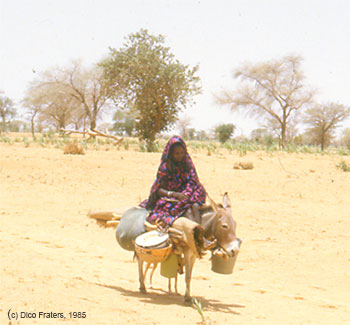Cawyaŋ Zarma Sanni |

Lesson 2. Wayboro fo koy Ɲamay
Content
|
|||||||||||||||||||||||||||||||||
2.A. Intro |
|||||||||||||||||||||||||||||||||
|
|||||||||||||||||||||||||||||||||
2.B. Vocabulary |
|||||||||||||||||||||||||||||||||
|
Learn these words by heart. Extra |
|||||||||||||||||||||||||||||||||
|
|||||||||||||||||||||||||||||||||
|
|||||||||||||||||||||||||||||||||
|
|||||||||||||||||||||||||||||||||
|
|
|||||||||||||||||||||||||||||||||
2.C. Grammar |
|||||||||||||||||||||||||||||||||
|
It is important to realise that Zarma grammar sometimes differs from English grammar or from grammar of other European languages likes German or French. With one respect Zarma grammar is not so different, the number of exception on rules is at least equal to the number of rules and sometimes it is not possible to discover rules at all. In such cases the only way to learn the language is to learn those thing by heart. Subjects in this lesson: |
|||||||||||||||||||||||||||||||||
2.C.1. Direct object, introductionFirst, let us review the three general types of objects of verbs:
Note: The linking verbs, to be, to exist, do not fall into any of these categories. General ruleThe direct object in Zarma generally precedes the verb, while the indirect object and adverbial and other modifiers regularly follow it (see examples in 2.C.2 below). General exceptionThere is one general class of verbs, those showing subjective perception or emotion, which regularly take the direct object afterwards, see section 2.C.3 These verbs will be marked with an # in the dictionary and the vocabulary lists as they occur in lessons. Other exceptionsA very few common verbs (notably 'to buy' and 'to sell') will sometimes be heard with the direct object after them, but the regular way is correct as well, and more commonly heard. In section 2.C.3 to the above rules will be discussed. Verb auxiliaryWhen there is a direct object before the verb, there is always some kind of verb auxiliary (also called particle) preceding it to distinguish it from the subject. But in all tenses, aspects and moods of the verb, the same sentence order is preserved. |
|||||||||||||||||||||||||||||||||
2.C.2. The auxiliary 'na' to indicate a direct object in past tense |
|||||||||||||||||||||||||||||||||
In the past tense, when the direct object precedes the verb, it is pointed out and distinguished from the subject by the auxiliary 'na' . This 'na' precedes the direct object (see examples below). |
|||||||||||||||||||||||||||||||||
|
|||||||||||||||||||||||||||||||||
Note: This 'na' as a completed tense indicator only occurs where a direct object precedes the verb, whether or not the verb is followed by an adverbial modifier, indirect object or even a compound direct object when this follows the verb. When the personal pronouns which begin with a vowel (ay, a, iri, araŋ, i) are used as direct objects, the 'na' generally contracts with 'a' and 'i' (see examples below). This contraction sometimes occurs with other pronouns beginning with a vowel as well . When this contraction occurs, the pronoun is strongly accented. |
|||||||||||||||||||||||||||||||||
|
|||||||||||||||||||||||||||||||||
The vowel of this 'na' particle, and indeed of all auxiliaries is very short, little more than a grunt. |
|||||||||||||||||||||||||||||||||
2.C.3. Direct object, exceptions of sentence order |
|||||||||||||||||||||||||||||||||
|
The direct object usually precedes the verb (see 2.C.1). There is one general class of verbs, which regularly take the direct object afterwards. These are verbs showing subjective perception or emotion, such as 'maa' (to hear) en 'kande' (to bring) (see examples below). These verbs are marked with an '#' in the dictionary and the vocabulary lists as they occur in lessons. A full list is given in the grammar book. |
|||||||||||||||||||||||||||||||||
|
|||||||||||||||||||||||||||||||||
For direct objects which precede the verb (see 2.C.1), there is a possible exception. This is not a obligatory exception ! When two or more nouns are used as direct objects, they may follow the verb. |
|||||||||||||||||||||||||||||||||
|
|||||||||||||||||||||||||||||||||
Note that it would be just as correct to say: "I na bari da yo kaaru". |
|||||||||||||||||||||||||||||||||
| In Zarma there is a group of verbs that can be either transitive or intransitive, depending on the meaning and context, similar to English. A transitive verb takes a direct object: it shows action upon someone or something. Intransitive verbs take no direct object; they need only a subject to make a sentence. For example, the verb 'kaaru' in combination with the postposition 'boŋ' is intransitive and means 'to mount'. Without this postposition 'kaaru' means 'to ride' and is transitive (see exampels below). The English translation of the verb might be in both cases transitive. |
|||||||||||||||||||||||||||||||||
|
|||||||||||||||||||||||||||||||||
2.C.4. The verbs come and go |
|||||||||||||||||||||||||||||||||
|
The verbs of motion 'koy' (go) and 'kaa' (come), which ordinarily take the preposition 'to' in English before their adverbial object, do not require it in Zarma when the object is 'fu' (home, house), 'kwaara' (town, village), or the name of a specific town or country. |
|||||||||||||||||||||||||||||||||
|
|||||||||||||||||||||||||||||||||
2.C.5. The conjunction 'nda' |
|||||||||||||||||||||||||||||||||
Two (or more) nouns or pronouns, with their adjective modifiers, may be connected in Zarma by the conjunction 'nda'. However, 'nda' is not used to connect adjectives, verbs, or clauses. If there is a string of nouns, where we would normally use a comma to separate all but the last two in English, in Zarma 'nda' or its abbreviation 'da' must be used for all of them, and not a comma. This 'nda' is one syllable, short vowel, and the 'n' is often not detectable. |
|||||||||||||||||||||||||||||||||
|
|||||||||||||||||||||||||||||||||
There are ways of connecting clauses, but that comes later in Lesson 5.D.5. It isn't 'nda'. You could always make two separate sentences (see example below). |
|||||||||||||||||||||||||||||||||
|
|||||||||||||||||||||||||||||||||
2.C.6. Review of sentence order learned at this point |
|||||||||||||||||||||||||||||||||
1. With the regular transitive verbs (the article may or may not be present): |
|||||||||||||||||||||||||||||||||
2. With the intransitive verb: |
|||||||||||||||||||||||||||||||||
| disclaimer | contact | ||||||||
| Dico Fraters, the Netherlands © 2004-2016 | |||||||||
|
|
|||||||||



